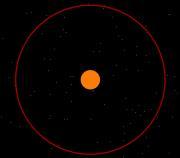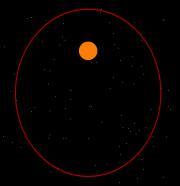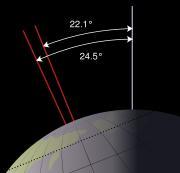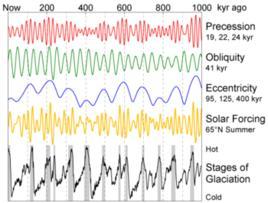运行轨道的三个变化
1.
地球公转轨道离心率的变化
为一个约九万六千年的周期。其间地球的轨道皆在圆形与椭圆形之间变化
。轨道离心率越小(越接近圆形)时,四季变化相对较不明显,也不易有冰期的发生。反之,离心率越接
近1(但不等于)的轨道,四季明显,也较易产生冰期。
2.地球自转轴倾斜角度的变化
地球自转轴的倾斜角度介于21.5度到24.5度之间,以四万一千年为周期。
角度越大,高纬度地区因接受辐射的时间差异较大,易形成冰期。现今地球自转轴倾斜角度为23.44度,
且有减少的迹象。
3.地球的岁差
因地球自转轴的进动,造成一个大约两万六千年的周期。在远日点时,若北半球倾向太阳
,冬天温度将会相对较高;若因进动而导致南半球在远日点时倾向太阳,北半球的冬天将较为酷寒。又
因北半球陆地多,比热小,温度容易下降,而较容易形称冰期。
但,米兰科维奇循环并未完全解释气候的变化,特别是冰期的产生,因为冰期的发生显然小于十万年这
个周期。
上述三种因素会集合影响地球的气温变化,例:当地球在远日点且绕日运行的轨道离心率趋近于1,地球
自转轴倾斜角度为最大的24.5度,且南半球倾向太阳,将可能发生极低温的情形。此三个因素交错影响
着地球气温,每个因素不同的表现也让地球的气温更加不可预测。
Earth’s movements
Milankovitch cycles are the collective effect of changes in the Earth's movements upon its climate, named after Serbian civil engineer and mathematician Milutin Milanković. The eccentricity, axial tilt, and precession of the Earth's orbit vary in several patterns, resulting in 100,000-year ice age cycles of the Quaternary glaciation over the last few million years. The Earth's axis completes one full cycle of precession approximately every 26,000 years. At the same time, the elliptical orbit rotates, more slowly, leading to a 21,000-year cycle between the seasons and the orbit. In addition, the angle between Earth's rotational axis and the normal to the plane of its orbit moves from 22.1 degrees to 24.5 degrees and back again on a 41,000-year cycle. Currently, this angle is 23.44 degrees and is decreasing.
As the Earth spins around its axis and orbits around the Sun, several quasi-periodic variations occur. Although the curves have a large number of sinusoidal components, a few components are dominant. Milankovitch studied changes in the eccentricity, obliquity, and precession of Earth's movements. Such changes in movement and orientation change the amount and location of solar radiation reaching the Earth. This is known as solar forcing (an example of radiative forcing). Changes near the north polar area are considered important due to the large amount of land, which reacts to such changes more quickly than the oceans do.
Orbital shape (
eccentricity) 轨道形状(
偏心率)

正常的形状

反常
The Earth's orbit is an ellipse. The eccentricity is a measure of the departure of this ellipse from circularity. The shape of the Earth's orbit varies from being nearly circular (low eccentricity of 0.005) to being mildly elliptical (high eccentricity of 0.058) and has a mean eccentricity of 0.028. The major component of these variations occurs on a period of 413,000 years (eccentricity variation of ±0.012). A number of other terms vary between 95,000 and 136,000 years, and loosely combine into a 100,000-year cycle (variation of −0.03 to +0.02). The present eccentricity is 0.017.
If the Earth were the only planet orbiting our Sun, the eccentricity of its orbit would not vary in time. The Earth's eccentricity varies primarily due to interactions with the gravitational fields of Jupiter and Saturn. As the eccentricity of the orbit evolves, the semi-major axis of the orbital ellipse remains unchanged. From the perspective of the perturbation theory used in celestial mechanics to compute the evolution of the orbit, the semi-major axis is an adiabatic invariant. According to Kepler's third law the period of the orbit is determined by the semi-major axis. It follows that the Earth's orbital period, the length of a sidereal year, also remains unchanged as the orbit evolves.
Currently the difference between closest approach to the Sun (perihelion) and furthest distance (aphelion) is only 3.4% (5.1 million km). This difference is equivalent to about a 6.8% change in incoming solar radiation. Perihelion presently occurs around January 3, while aphelion is around July 4. When the orbit is at its most elliptical, the amount of solar radiation at perihelion is about 23% greater than at aphelion. This difference is roughly 4 times the value of the eccentricity.
Season (Northern Hemisphere) Durations
Year Date: GMT Season Duration
2005 Winter Solstice 12/21/2005 18:35 88.99 days
2006 Spring Equinox 3/20/2006 18:26 92.75 days
2006 Summer Solstice 6/21/2006 12:26 93.65 days
2006 Autumn Equinox 9/23/2006 4:03 89.85 days
2006 Winter Solstice 12/22/2006 0:22 88.99 days
2007 Spring Equinox 3/21/2007 0:07 没被记录
本资料来自http://aa.usno.navy.mil
Orbital mechanics require that the length of the seasons be proportional to the areas of the seasonal quadrants, so when the eccentricity is extreme, the seasons on the far side of the orbit can be substantially longer in duration. When autumn and winter occur at closest approach, as is the case currently in the northern hemisphere, the earth is moving at its maximum velocity and therefore autumn and winter are slightly shorter than spring and summer. Thus, summer in the northern hemisphere is 4.66 days longer than winter and spring is 2.9 days longer than autumn.
Axial tilt (obliquity)

22.1-24.5° range of Earth's obliquity.
The angle of the Earth's axial tilt (obliquity) varies with respect to the plane of the Earth's orbit. These slow 2.4° obliquity variations are roughly periodic, taking approximately 41,000 years to shift between a tilt of 22.1° and 24.5° and back again. When the obliquity increases, the amplitude of the seasonal cycle in insolation (INcident SOLar radiATION) increases, with summers in both hemispheres receiving more radiative flux from the Sun, and the winters less radiative flux. As a result, it is assumed that the winters become colder and summers warmer.But these changes of opposite sign in the summer and winter are not of the same magnitude. The annual mean insolation increases in high latitudes with increasing obliquity, while lower latitudes experience a reduction in insolation. Cooler summers are suspected of encouraging the start of an ice age by melting less of the previous winter's ice and snow. So it can be argued that lower obliquity favors ice ages both because of the mean insolation reduction in high latitudes as well as the additional reduction in summer insolation.
Currently the Earth is tilted at 23.44 degrees from its orbital plane, roughly half way between its extreme values. The tilt is in the decreasing phase of its cycle, and will reach its minimum value around the year 10,000 AD.
Precession (wobble)
Precession is the change in the direction of the Earth's axis of rotation relative to the fixed stars, with a period of roughly 26,000 years. This gyroscopic motion is due to the tidal forces exerted by the sun and the moon on the solid Earth, associated with the fact that the Earth is not a perfect sphere but has an equatorial bulge. The sun and moon contribute roughly equally to this effect. In addition, the orbital ellipse itself precesses in space (anomalistic precession), primarily as a result of interactions with Jupiter and Saturn. This orbital precession is in the opposite sense to the gyroscopic motion of the axis of rotation, shortening the period of the precession of the equinoxes with respect to the perihelion from 26,000 to 21,000 years.
When the axis is aligned so it points toward the Sun during perihelion, one polar hemisphere will have a greater difference between the seasons while the other hemisphere will have milder seasons. The hemisphere which is in summer at perihelion will receive much of the corresponding increase in solar radiation, but that same hemisphere will be in winter at aphelion and have a colder winter. The other hemisphere will have a relatively warmer winter and cooler summer.
When the Earth's axis is aligned such that aphelion and perihelion occur near the equinoxes, the Northern and Southern Hemispheres will have similar contrasts in the seasons.
At present, perihelion occurs during the Southern Hemisphere's summer, and aphelion is reached during the southern winter. Thus the Southern Hemisphere seasons are somewhat more extreme than the Northern Hemisphere seasons, when other factors are equal.










